Placed together, we are citizens of the world.
La Biennale di Venezia: 60th International Art Exhibition
November 1, 2024
【Special Feature 083】
From April 20 to November 24, 2024, the Japanese Pavilion at the 60th International Art Exhibition in Venice (hereafter, the Venice Biennale) is hosting the exhibition Compose by artist Yuko Mohri. On July 27, a review session was held in person and online at the Sakura Hall of the Japan Foundation, which serves as the Japanese Pavilion commissioner. The session featured a conversation between Mohri and Sook-Kyung Lee, the pavilion curator, and was moderated by Azusa Hashimoto, the curator at the National Museum of Art, Osaka. The following report is about this review session and also the author's on-site experience as a coordinator for the Compose exhibition.
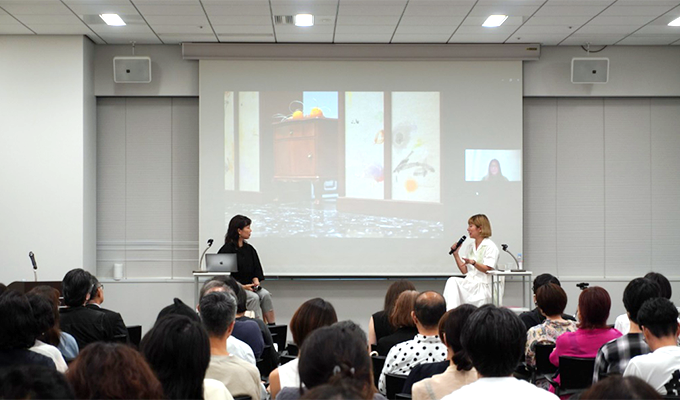 The review session (Above left, Azusa Hashimoto; above right, Yuko Mohri; screen right, Sook-Kyung Lee).
The review session (Above left, Azusa Hashimoto; above right, Yuko Mohri; screen right, Sook-Kyung Lee).A New Step for the Japanese Pavilion
Historically, the Japanese Pavilion at the Venice Biennale selected its curators through competitions with the experts in the field, but since the previous exhibition (2022), it has been selecting its artists directly and allowed them to select their own curator.
Mohri first received the invitation to Venice in April 2023 when she was in Korea for the opening of the Gwangju Biennale. At that time, Sook-Kyung Lee was the artistic director of the Gwangju Biennale, and the title of the exhibition was Soft and Weak like Water (an adaptation of a line in the Dao De Jing. Coincidentally, Mohri's work includes the kinetic-art series involving water that is titled Moré Moré (Leaky), making the meeting of these two women fortuitous and momentous.
Mohri recalls the thought-provoking and stimulating discussions she had with other artists at Gwangju about the pliability of water. However, she and Lee--a fellow East Asian and, at the time, a senior curator of international art at London's Tate Modern--were well aware that Eastern ideas about water are vastly different from those of the West. To further this dialogue, Mohri asked Lee to be the curator of her exhibition at the Japanese Pavilion.
Mohri observed that only Japanese artists and curators had been featured in past exhibitions at the Japanese Pavilion. She indirectly challenged this norm through her natural tendency to work with curators of diverse backgrounds who have exhibited in Japan and abroad. Rather than attempting to represent only one country, she encouraged the Japanese Pavilion to welcome like-minded curators, regardless of their nationality.
Lee, a long-time observer of Mohri's work, said she was surprised and honored to receive Mohri's request to curate the Japanese Pavilion exhibition.
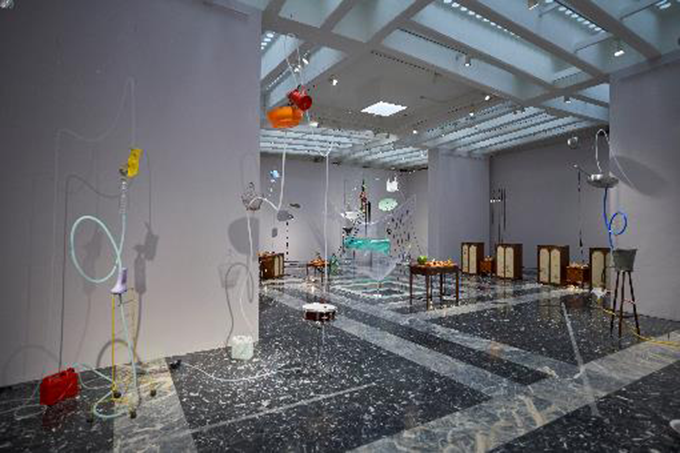 Compose by Yuko Mohri in the Japanese Pavilion at the 60th International Art Exhibition in Venice (Photo by kugeyasuhide)
Compose by Yuko Mohri in the Japanese Pavilion at the 60th International Art Exhibition in Venice (Photo by kugeyasuhide)"Water" for Venetians
Venice, the host of the world's longest-running biennale (international contemporary art exhibition), is famously known as the City of Water. Even this historic city, however, has experienced damage from this often-unpredictable natural element. About a year ago, when Mohri was planning her exhibition, she initially chose to include Moré Moré (Leaky) in deference to Venice's unique topography. After discussing this with Lee, she decided to present Decomposition--a series that includes fruit as a material--embracing the structure of the Japanese Pavilion as part of the exhibition.
Mohri's production process began with a two-month stay in Venice and its vicinity to conduct research. In the cool month of February, with Venice shrouded in fog and St. Mark's Square flooded with seawater, Mohri discovered a part of the city where a raised pedestrian walkway had been built. The pathways leading off the atrium and courtyard fountain in the Fondazione Querini Stampalia building, designed by architect Carlo Scarpa, are connected to the waterways that crisscross Venice, but at the time Mohri visited the complex, the water was gone unlike elsewhere in Venice. She learned that the Mose system, which is a series of barriers consisting of mobile gates designed to prevent major flooding, functions in relation to the tides. She also became aware of a calendar showing the phases of the moon that hung in a local restaurant she often visited. Being well aware that Japan has, in recent years, experienced sudden heavy rains that often result in flooding, Mohri came to recognize differences in how the residents of Japan and those of Venice perceive water as an essential element and live in relation to it.
Mohri went on to visit organic farmers in the suburbs of Venice, and also spoke with an agronomist who works in the Giardini area, where the Venice Biennale is held. They talked about organic composting, which deepened Mohri's understanding of contemporary initiatives in the context of Venice's history as a trading center.
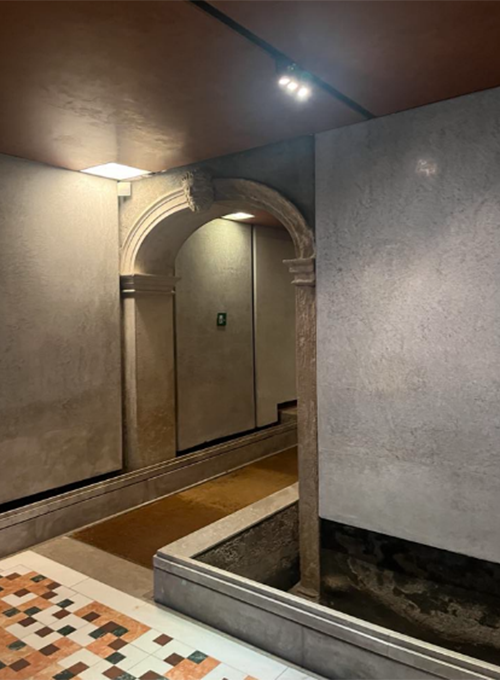 Interior of the Fondazione Querini Stampalia without water by Carlo Scarpa (Photo by Koshiro Shikine)
Interior of the Fondazione Querini Stampalia without water by Carlo Scarpa (Photo by Koshiro Shikine) An apple orchard in Treviso, a suburb of Venice, which Mohri visited for research (Photo by Koshiro Shikine)
An apple orchard in Treviso, a suburb of Venice, which Mohri visited for research (Photo by Koshiro Shikine)Mohri frequently met online with Lee to discuss how best to set up the exhibition so that it fit with the distinctive architecture of the Japanese Pavilion. She eventually decided to use the pavilion as a studio, building the installation there. Considering the high transportation costs and the negative environmental impact of creating the works in Japan and shipping them all the way to Venice, Mohri took the enterprising step of sourcing unsalable antique furniture and household items, as well as unsalable fruits, all given to her by people in Venice and its suburbs.
During the exhibition, some visitors even tried to retrace Mohri's footsteps as she had collected these items, wondering if the canal boat they had seen selling fruit in the town was where Mohri had obtained the fruit for her installation.
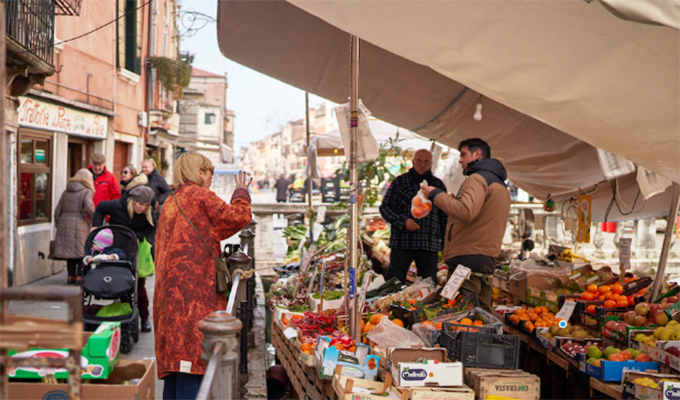 Mohri procures fruit for her artwork. The way vendors do business with their cargo on a boat is typical of Venice. (Photo by kugeyasuhide)
Mohri procures fruit for her artwork. The way vendors do business with their cargo on a boat is typical of Venice. (Photo by kugeyasuhide)Rain Falls, Wind Dances, and Sound Fills the Japanese Pavilion
The preview (vernissage in Italian) of the Venice Biennale was held from April 17 to 19 and attracted many guests and officials from around the world. As of July 27, the number of visitors to the Japanese Pavilion was 211,249.
At one point during the preview, a breeze entered the pavilion through the skylight and through the hole in the floor leading to the pilotis, shaking the vinyl tarp that was part of the installation. This in turn periodically triggered a small chime, and raindrops falling into the pavilion bounced off the tarp. Visitors marveled at the interaction between the distinctive architecture of the Japanese Pavilion and the artwork therein, which reacted to its natural surroundings.
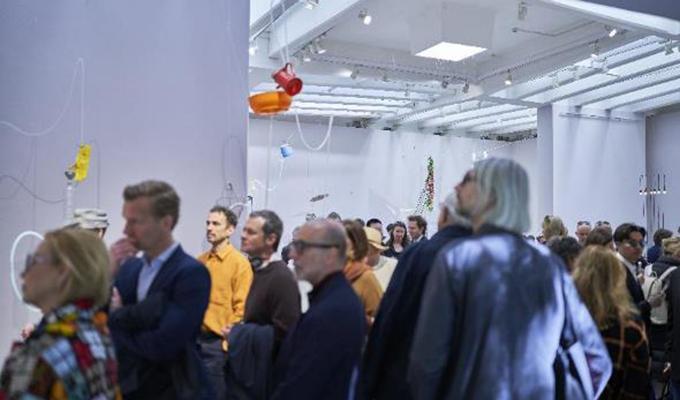 The Japanese Pavilion during the vernissage was crowded with guests. (Photo by kugeyasuhide)
The Japanese Pavilion during the vernissage was crowded with guests. (Photo by kugeyasuhide)Mohri had brought a fruit dryer from Japan, and while setting up the exhibition, she and the staff took turns making dried apple chips. These were served to guests at the opening reception along with apple beer brought by Marisa, an organic farmer Mohri had visited for research.
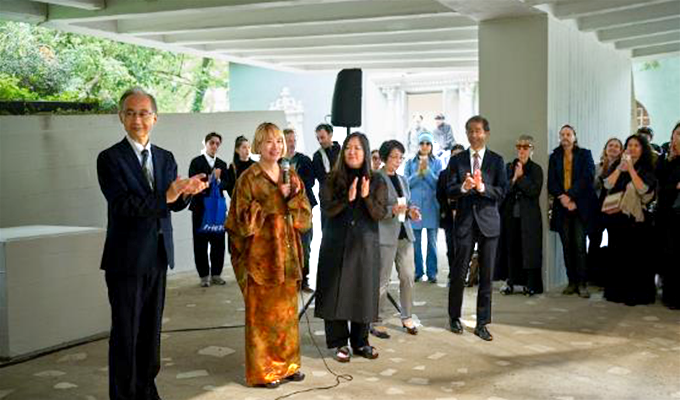 Opening speech at the Japanese Pavilion piloti (Center left, Yuko Mohri; center right, Sook-Kyung Lee) (Photo by kugeyasuhide)
Opening speech at the Japanese Pavilion piloti (Center left, Yuko Mohri; center right, Sook-Kyung Lee) (Photo by kugeyasuhide)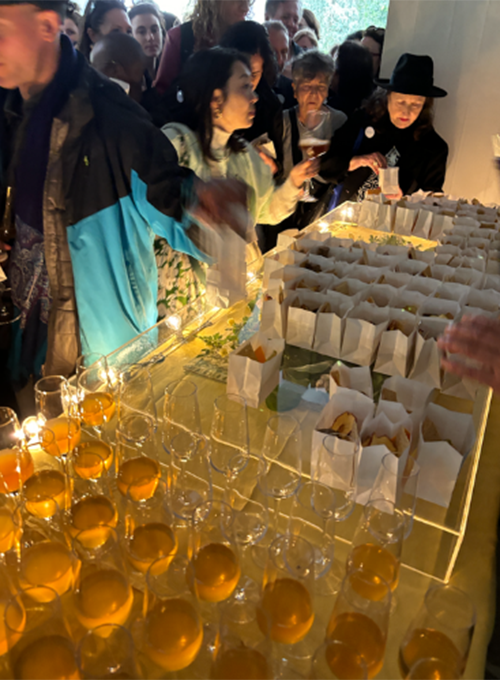 Fruit playing its role at the opening (Photo by the author)
Fruit playing its role at the opening (Photo by the author)Following the reception, there was plenty of press coverage and visits from representatives of leading international museums, including a special group from the Camden Art Centre in London. Mohri held a solo exhibition there (having previously been given a residency) after winning the Grand Prix Nissan Art Award 2015 with her first presentation of Moré Moré (Leaky). The Japanese Pavilion team was particularly happy to welcome a Korean newspaper reporter to cover the collaboration of the artist and the curator across countries. *1
The four galleries that Mohri works with jointly funded and hosted a party after the reception to celebrate the opening of the exhibition. The opening was attended by more than 150 guests, including donors who had supported the Japanese Pavilion exhibition and those who had supported Mohri throughout her career. Guests were presented with special commemorative bags made of woven electrical wires reminiscent of Mohri's work (designed in collaboration with by Miyake Design Studio) and a catalog published to coincide with the opening of the exhibition.
The party was noteworthy as it also marked the first time that galleries who ordinarily work independently in Taiwan, Dublin, London, Tokyo, and New York would come together in Venice for a collaborative event. *2
Citizens of the World
This is the second time that Lee, who was the curator of the Korean Pavilion at the 2015 Venice Biennale, has been involved with a national pavilion. When asked about her collaboration with Mohri at the review, she said that her goal had been to present Mohri's unique and clear concept in a global context to give her creative endeavors more visibility. She added that the "water" connected her with Mohri at the Gwangju Biennale is soft and inconspicuous, and as we think deeply about it, our awareness of the invisible increases.
Lee has repeatedly described the Venice Biennale as "a platform for collective consideration of what is happening in the world today." She emphasizes that the Venice Biennale, with its almost 100 national pavilions throughout the city, brings together diverse perspectives on world events and the major issues people face, even if the political, social, and economic situations in their countries differ. Her words are impressive: "If we see ourselves as citizens of the world, instead of individuals of separate countries, we may discover that we are facing the same problems." She stresses that art has the power to influence a seemingly disjointed world and change our daily lives as we attempt to deal with even small crises, although it may sometimes expose vulnerabilities. Lee's insight inspired the title of Mohri's exhibition, Compose, which represents the idea of "putting together".
All artists, regardless of where they live, respond with their own creations to situations simultaneously affecting the world, such as the pandemic, the Black Lives Matter movement, and the climate crisis. Mohri emphasized that her unique point of view and research-based expression asks how we can comprehend our existence in a society fraught with difficulties.
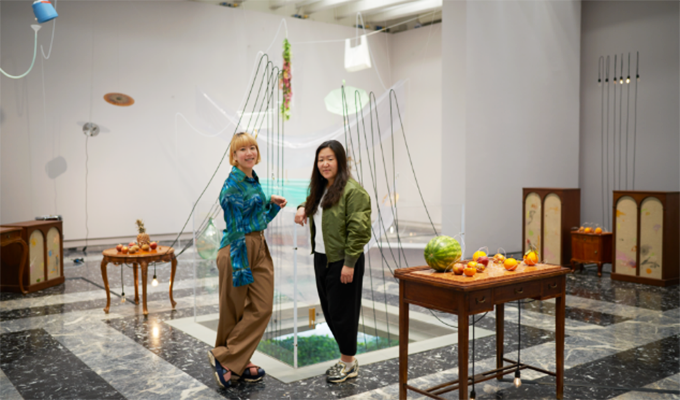 Awaiting guests after completing the Japanese Pavilion installation (Photo by kugeyasuhide)
Awaiting guests after completing the Japanese Pavilion installation (Photo by kugeyasuhide)The Venice Biennale opened at the time overtourism was becoming a concern, and Venice was testing an entry fee for tourists. Foreigners Everywhere is the title of the 60th International Art Exhibition, curated by Adriano Pedrosa, who is the artistic director of the Museu de Arte de São Paulo (MASP), and the exhibition could evoke a wider variety of reactions.
Describing Pedrosa's work as "a challenging task," Lee explained that the Venice Biennale looks at modern and contemporary art and ambitiously incorporates diverse perspectives from the Global South, LGBTQ+ people, women, and people indigenous to the region that have rarely been included before. Yet, the artworks and the pavilions themselves are all part of the same exhibition. She said that linking the overall theme of the Venice Biennale with the individual pavilionsincurs both possibilities and limitations. She also shared her belief that it is important for a large international exhibition like the Biennale to ensure that artists' activities express the "now," while remaining a healthy platform where the themes of each of the pavilions are given a voice.
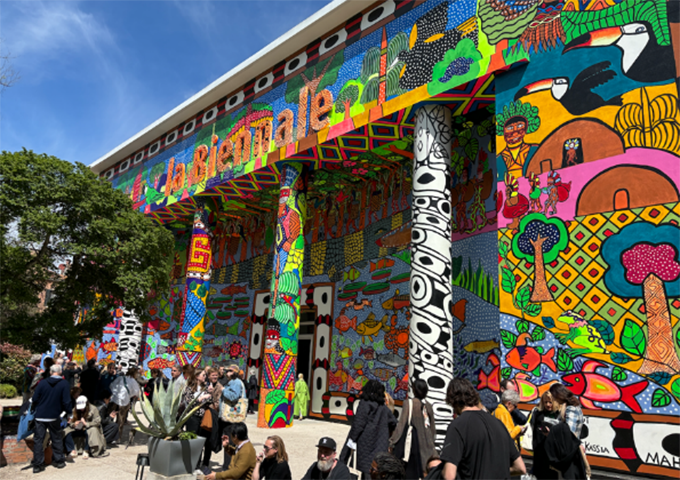 Giardini della Biennale, central pavilion facade (Photo by the author)
Giardini della Biennale, central pavilion facade (Photo by the author)The review concluded with Lee answering a question about the future of Japanese artists and the art community. She explained that the Japanese Pavilion exhibition was a good opportunity to show the direction in which Japanese art will move on the international stage. She praised Japanese artists' work as particularly unique and encouraged them to remain open-minded and connect with the world, expressing their viewpoints on a broader stage and revealing how their daily lives are reflected in their work.
Afterword
When the Venice Biennale closes on November 24, I will have served as coordinator and publicist of this project for almost a year. Yuko Mohri's initial idea was effectively a new step, and it presented me with a fresh challenge--crafting a truly international exhibition. As I struggled to negotiate and organize my way through the chaos of various tasks--somewhat like preventing water from leaking in Moré Moré (Leaky)--I sensed the magnitude of the platform, the weight of great responsibility, and a trembling joy as I exchanged words with visitors to the Japan Pavilion from all over the world.
As with any exhibition, the opening of each pavilion is scheduled to the minute. Music plays during special performances, and voices echo from the speakers. When setting up the exhibition, we also assessed to what extent the sound produced by the installation could be heard in the surrounding area. Artists and curators of the British, French, Czech, Slovak, and Japanese pavilions occasionally gathered in the central plaza to share information about each other's installations and to confirm schedules and discuss concerns.
There are also no borders between the pavilions at the Giardini - each one is clearly visible, inspiring empathy. Negotiation and, above all, mutual consideration are necessary in designing the waiting lines and the sequence of events for visitor accessibility and in deciding where to hold press conferences and events. I believe that the Venice Biennale is called the Olympics of Art because of the way each pavilion respects its neighboring pavilions, creating a mutually satisfying exhibition. This occasion brought to mind the kind of person I want to be and how I should treat others when collaborating with people of different backgrounds and nationalities--which helped me to realize the following: "We are placed together, we are citizens of the world."
Like Lee, I hope more people in all fields will think together about the direction of the Japanese Pavilion in the future and how we can collaborate with people around the world. We can become the pillars that support the Japanese Pavilion by accompanying the artists and curators in realizing exhibits.
I would like to once again express my gratitude to Yuko Mohri, who spent most of the first half of this project negotiating and actively engaged with local people during her research. As a result, she has produced a work that captures the state of the world, clearly reflected in the enlightened expressions of those visiting the Japanese Pavilion. To Sook-Kyung Lee, whose global and curatorial perspective provided us the opportunities in thinking how the international art exhibition to be shown in today's world and the operation of the pavilion in it. I would also like to express my gratitude to everyone at the Japan Foundation, which provided support from both Tokyo and Rome, and to the staff who supported the Japanese Pavilion throughout the exhibition period *3.
Shintaro Tokairin (Japanese Pavilion Compose Exhibition Coordinator, Public Relations)
- *1 The Korean Pavilion, next to the Japanese Pavilion, is also welcoming a foreign curator for the first time--Jacob Fabricius from Denmark. I will never forget how we chatted happily about our new endeavors over the hedgebetween the two pavilions
- *2 In addition, the after-party was hosted together by Mohri, the Australian Pavilion, which won the Golden Lion, the Singapore Pavilion, and the artists from Aotearoa (New Zealand), who exhibited in the Central Pavilion.
- *3 The people who supported the exhibition include the local coordinators and the installation team, as well as the supervision staff, who worked closer and longer than anyone else with the artworks. Many of the supervision staff also have a wealth of expertise in the field of art, and many of them chose specifically to supervise the Japanese Pavilion.
*Links to main coverage:
- Asia Art Pacific
https://artasiapacific.com/issue/yuko-mohri-electric-smelly-orchestra - ArtReview
https://artreview.com/yuko-mohri-on-representing-japan-at-the-60th-venice-biennale/ - Frieze (in conversation with Korean Pavilion artist Koo Jeong A.)
https://www.frieze.com/article/koo-jeong-yuko-mohri-conversation-2024 - STIRworld
https://www.stirworld.com/inspire-people-artist-yuko-mohri-on-creating-work-with-a-focus-on-ecological-consciousness - artnet
https://news.artnet.com/art-world/yuko-mohri-japan-pavilion-2491145 - Tokyo Art Beat
https://www.tokyoartbeat.com/articles/-/sook-kyung-lee-yuko-mohri-interview-202405 - Louisiana Channel
https://www.youtube.com/watch?v=oEYjaVI5bXs&t=17s
Keywords
Back Issues
- 2025.6.24 Exclusive Interview:…
- 2025.5. 1 Ukrainian-Japanese I…
- 2024.11. 1 Placed together, we …
- 2024.5.24 The 50th Japan Found…
- 2024.5.24 The 50th Japan Found…
- 2024.5. 2 People-to-People Exc…
- 2024.2.19 Movie Theaters aroun…
- 2024.2.19 Movie Theaters aroun…
- 2023.4.24 The 49th Japan Found…
- 2022.10.24 Inner Diversity <2> …

